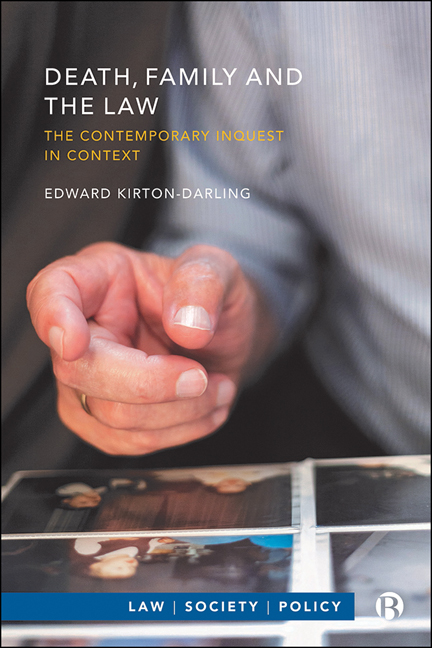Book contents
- Frontmatter
- Contents
- Acknowledgements
- Series Editor’s Preface
- 1 Death, Family and the Law
- 2 Accountability and Authority in the Historical Jurisdiction
- 3 Accountability Reconceived
- 4 First Contact and the Next of Kin
- 5 Dignity, the Family and the Body
- 6 Family in the Driving Seat
- 7 The Public(?) Hearing
- 8 Reimagining the Inquest
- Bibliography
- Index
4 - First Contact and the Next of Kin
Published online by Cambridge University Press: 08 October 2022
- Frontmatter
- Contents
- Acknowledgements
- Series Editor’s Preface
- 1 Death, Family and the Law
- 2 Accountability and Authority in the Historical Jurisdiction
- 3 Accountability Reconceived
- 4 First Contact and the Next of Kin
- 5 Dignity, the Family and the Body
- 6 Family in the Driving Seat
- 7 The Public(?) Hearing
- 8 Reimagining the Inquest
- Bibliography
- Index
Summary
Introduction
First contact with family is a vital part of analysing understandings of both family and the contemporary inquest. In particular, it is essential in exploring the role that family are understood to play in establishing the system as a process of community accountability, in which tacit, meaningful connection to the deceased can enable the possibility of a meaningful explanation for death. It is also a critical moment for beginning to analyse the ways in which kinship can be constructed in the process of the inquest in the interplay between indeterminate law, official understanding and family practices.
The chapter is divided into five parts. It opens by examining the legal category of ‘next of kin’ and the importance of focusing on practices and processes, before moving to provide details on the vignettes I used to explore the way in which the decision makers understood the role of family. Following this, I elaborate on the ways in which the first contact with next of kin establishes kinship, use insights from scholarship on decision making to help to understand this process, and close with an explanation of my use of ‘framing’ as a way of understanding how decisions about family in the inquest system are made. Two frames are identified: one which corresponds with the modern understanding of accountability in the inquest as technocratic, and one which can be seen to emerge from a contemporary approach to the inquest, in which family participation is linked to the production of community accountability.
Making decisions, indeterminacy, and practices of family and kin
The opening obligation to the family is set out in Rule 6 of the Coroners (Investigations) Regulations 2013 SI 1629/ 2013:
A Coroner who is under a duty to investigate a death under section 1, must attempt to identify the deceased's next of kin or personal representative and inform that person, if identified, of the Coroner's decision to begin an investigation.
‘Next of kin’ is not used in the Coroners and Justice Act 2009 and first appeared in the 2013 Regulations. As Jervis on Coroners notes: ‘The phrase “next of kin” has no current technical meaning in English law and it is surprising that it is not defined for the purposes of the Coroner legislation’ (Matthews 2020, 198).
- Type
- Chapter
- Information
- Death, Family and the LawThe Contemporary Inquest in Context, pp. 72 - 98Publisher: Bristol University PressPrint publication year: 2022



